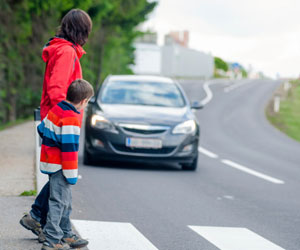Safe Crossings: The Power of Eye Contact
 It can be a dangerous world for pedestrians. Studies on French roads report that nearly 60% of drivers do not stop at all for pedestrians crossing the street at designated crosswalks.
It can be a dangerous world for pedestrians. Studies on French roads report that nearly 60% of drivers do not stop at all for pedestrians crossing the street at designated crosswalks.
New research suggests that pedestrians may have a better shot at crossing safely if they make direct eye contact with oncoming drivers.
Decades of research have shown that eye contact has a powerful effect in social interactions. People are far more likely to comply with requests — for example, donating money — when the person making the request looks them in the eye. Experiments on eye contact completed in the 1970s demonstrated that drivers stopped more than twice as often when hitchhikers looked them directly in the eye.
Psychological scientists Nicolas Guéguena (Université de Bretagne-Sud), Sébastien Meineri (Université de Bretagne-Sud), and Chloé Eyssartier (Cerema) designed an experiment to evaluate whether a pedestrian’s stare could convince drivers to stop at crosswalks.
For the study, four student confederates (two men and two women) were stationed at four different pedestrian crosswalks along city streets. The confederate was instructed to wait at the sidewalk until a car approached.
In the staring condition, the confederate looked at the driver’s face until the driver either stopped at the crosswalk or drove past. In the control condition, confederates were careful to look above the driver’s head, without actually making eye contact.
If a driver stopped, the confederate crossed the street and walked away for 10 seconds before returning to the crosswalk to repeat the procedure. Each confederate tested 10 drivers before switching experimental conditions.
Overall, the research team was able to obtain data from 2,560 drivers (1,488 men and 1,072 women). As predicted, pedestrian eye contact seemed to have a strong influence on driver behavior.
Without eye contact, about 55% of the drivers did not stop at the pedestrian crossing. However, when pedestrians stared directly at the driver’s eyes, about 68% of drivers stopped.
In both experimental conditions, the researchers found that gender played a significant role in whether or not a driver stopped; drivers stopped more often for female pedestrians (65%) than for male ones (58%). Male drivers were also more likely to stop when a male pedestrian stared at them (30%) than when a female pedestrian did (20%).
“The results of the present study confirmed our hypothesis: at pedestrian crossings significantly more drivers stop to permit to a pedestrian to cross the street when he or she looks the driver in the eye,”
However, future research will be needed to determine exactly why eye contact plays a role in this behavior. In some circumstances, direct eye contact can reflect status and dominance. In this study, “eye contact could have been perceived as a nonverbal form of order to stop.”
Eye contact can also lead to more positive relationships between strangers. Perhaps drivers were more likely to stop because even a brief period of direct contact initiated a more cordial, positive relationship between driver and pedestrian.
“Our results conducted in a field setting clearly support the assumption that making eye contact with a driver while waiting at the pedestrian crossing could be a relevant way to increase driver stopping behavior and by extension the safety of the pedestrian,” the researchers write in the journal Safety Science.
Reference
Guéguen, N., Meineri, S., & Eyssartier, C. (2015). A pedestrian’s stare and drivers’ stopping behavior: A field experiment at the pedestrian crossing. Safety Science, 75, 87-89. DOI:10.1016/j.ssci.2015.01.018





Comments
this clearly shows that eye contact impact human behavior
Cyclist are taught the same….the rule is that if a driver dosent make eye contact , you assume he dosent see you. I believe eye contact also pwesonalizes someone, meaning others (drivers in this case) are forced to recognize the pedestrian as a person.
I’ve found this to be true. When I stare at the approaching driver, they stop the vast majority of the time.
APS regularly opens certain online articles for discussion on our website. Effective February 2021, you must be a logged-in APS member to post comments. By posting a comment, you agree to our Community Guidelines and the display of your profile information, including your name and affiliation. Any opinions, findings, conclusions, or recommendations present in article comments are those of the writers and do not necessarily reflect the views of APS or the article’s author. For more information, please see our Community Guidelines.
Please login with your APS account to comment.